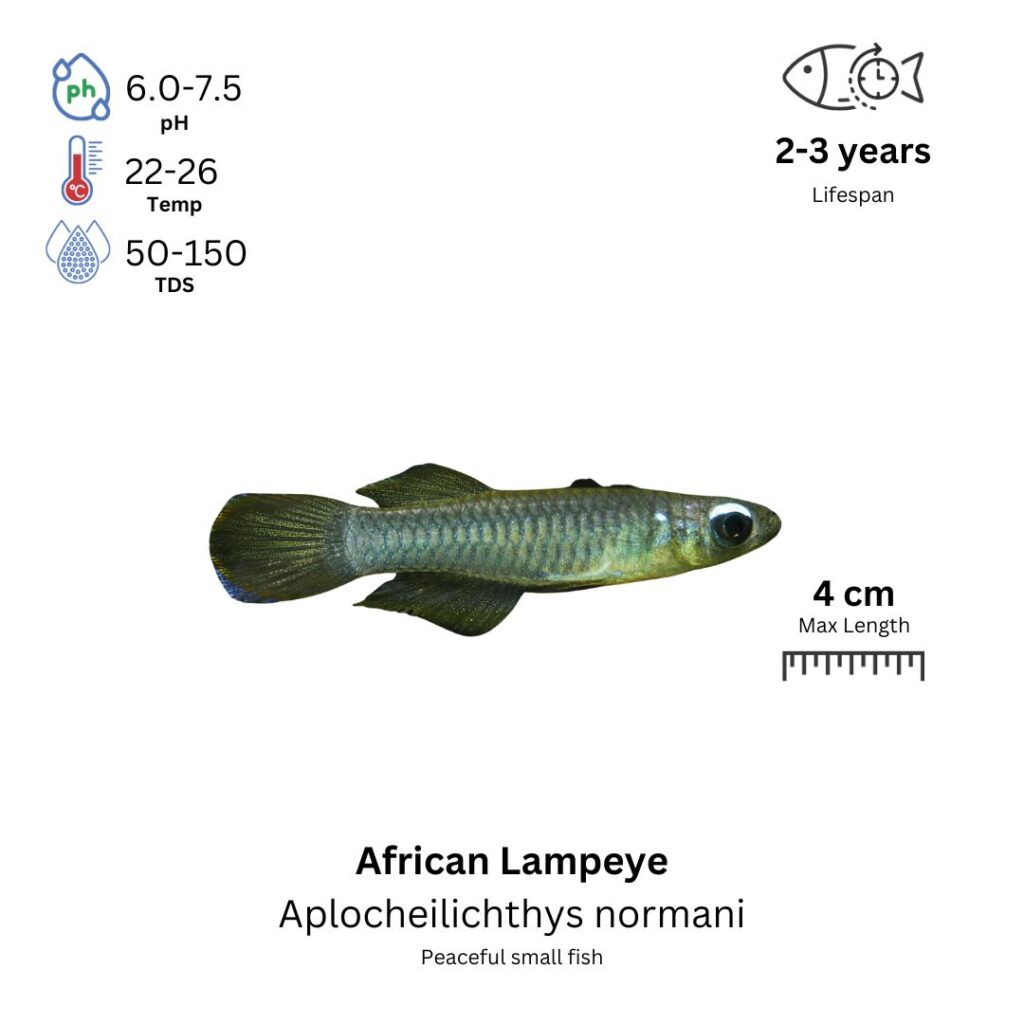African Lampeye
Poropanchax melanotus

Description
The African Lampeye is a small, attractive freshwater fish known for its distinctive eyes, which have a “lamp” or glow-like appearance due to the iridescent coloration around them. The body of the African Lampeye is typically silver or pale gold with a sleek, elongated shape. Males often exhibit more vibrant coloration with brighter shades of yellow, gold, or orange, while females are generally more subdued in color. The fish has a peaceful nature and is generally non-aggressive, making it an ideal species for community aquariums. African Lampeyes are active and social, often seen swimming in schools near the middle to upper parts of the tank.
Habitat Origin
Native to the West African rivers and streams, particularly in countries like Cameroon, Ghana, and Nigeria. These fish are typically found in slow-moving or still waters with dense vegetation, where they thrive in slightly acidic to neutral conditions.
Aquarium
Ideal Number in Aquarium: At least 6 individuals, as they are schooling fish and feel more secure in groups.
Favorite Food

African Lampeyes are omnivores and will accept a variety of foods. They can be fed high-quality flake food, micro pellets, and live or frozen foods like brine shrimp, daphnia, and bloodworms. They will also nibble on small plant matter and algae in the tank.
Behavior:
African Lampeyes are peaceful, non-aggressive fish that do well in schools of at least 6 individuals. They are active swimmers, often seen darting through the upper sections of the tank. Their behavior is most vibrant when they are kept in groups, and their shimmering, lamp-like eyes add a unique visual element to the aquarium. They are generally shy and may prefer hiding in plants or among aquarium decorations when they feel threatened. As with most schooling fish, they feel more secure in groups and will often display their best colors when kept with their own kind.
Special Care:
African Lampeyes prefer a well-planted tank with plenty of hiding spaces such as plants, rocks, and driftwood. They thrive in slightly acidic to neutral water conditions, with regular water changes and good filtration to maintain clean water. These fish are relatively hardy but should be provided with stable water parameters to prevent stress. Since they are small and somewhat shy, it’s important to keep them with other peaceful species that won’t intimidate them.
Compatibility with Other Fish:
Yes, African Lampeyes are excellent tankmates for other small, peaceful species. They do well in community aquariums with other tetras, rasboras, and small catfish. They are best housed with non-aggressive species that share similar water conditions. Larger or more aggressive species should be avoided, as they may stress or harm the Lampeyes due to their small size and timid nature.
Breeding Setup
Using a separate breeding tank is strongly recommended for African Lampeyes. While they may breed in a community setup, a dedicated tank gives you better control over environmental conditions and protects the eggs from being eaten. A 10-gallon (38-liter) tank is suitable for a small breeding group, while 20 gallons (75 liters) is ideal for larger groups or multiple pairs. Maintain water conditions at pH 6.0–7.5, temperature 24–28°C (75–82°F), and hardness 4–12 dGH. A gentle sponge filter is ideal for minimizing current and preserving delicate fry. Use fine gravel or sand, and include Java moss, Hornwort, or Anubias, as well as floating plants like Duckweed to mimic their natural spawning environment.
Conditioning for Breeding
Condition African Lampeyes by offering a nutritious, varied diet for about a week. Feed them high-quality flakes or micro pellets, as well as live or frozen foods like brine shrimp, bloodworms, and daphnia. Supplementing with blanched vegetables like spinach or peas enhances their health. Perform weekly water changes of 20–30% to maintain quality, and to trigger spawning, simulate rainy season cues with a larger 50% water change and a slight temperature increase to 28°C (82°F). This often activates breeding behavior, especially in softwater species like African Lampeyes.
Spawning Process
Spawning usually occurs early in the morning or shortly after optimal water changes. Males will intensify in color and display to attract females. Once the female lays the eggs, the male fertilizes them externally. Eggs are sticky and will attach to plant leaves, decorations, or substrate. A healthy female can lay 30–50 eggs per session. After spawning, it’s essential to remove the adult fish, as African Lampeyes may eat their own eggs or fry. Leaving the eggs undisturbed increases hatching success.
Fry Hatching & Feeding
Eggs typically hatch within 2–3 days, depending on temperature. The newly hatched fry will initially feed on their yolk sacs for the first couple of days. Afterward, begin feeding with infusoria or liquid fry food, then gradually introduce baby brine shrimp, microworms, or finely crushed flakes as the fry grow. Maintain consistent water temperature (24–28°C) and conduct small water changes (10–20%) daily or every other day. Avoid overfeeding, as leftover food can quickly spoil the water and threaten the health of the delicate fry.
Key Considerations
African Lampeyes reach breeding maturity at about 6–8 months of age. Males are typically smaller and more colorful, especially with enhanced fin markings during courtship, while females appear rounder and larger, particularly when gravid. Avoid sudden fluctuations in water temperature, pH, or hardness, and maintain excellent water quality through regular maintenance. Ensure the tank remains peaceful, as stress from tank mates or environmental instability can hinder breeding success and fry survival.
